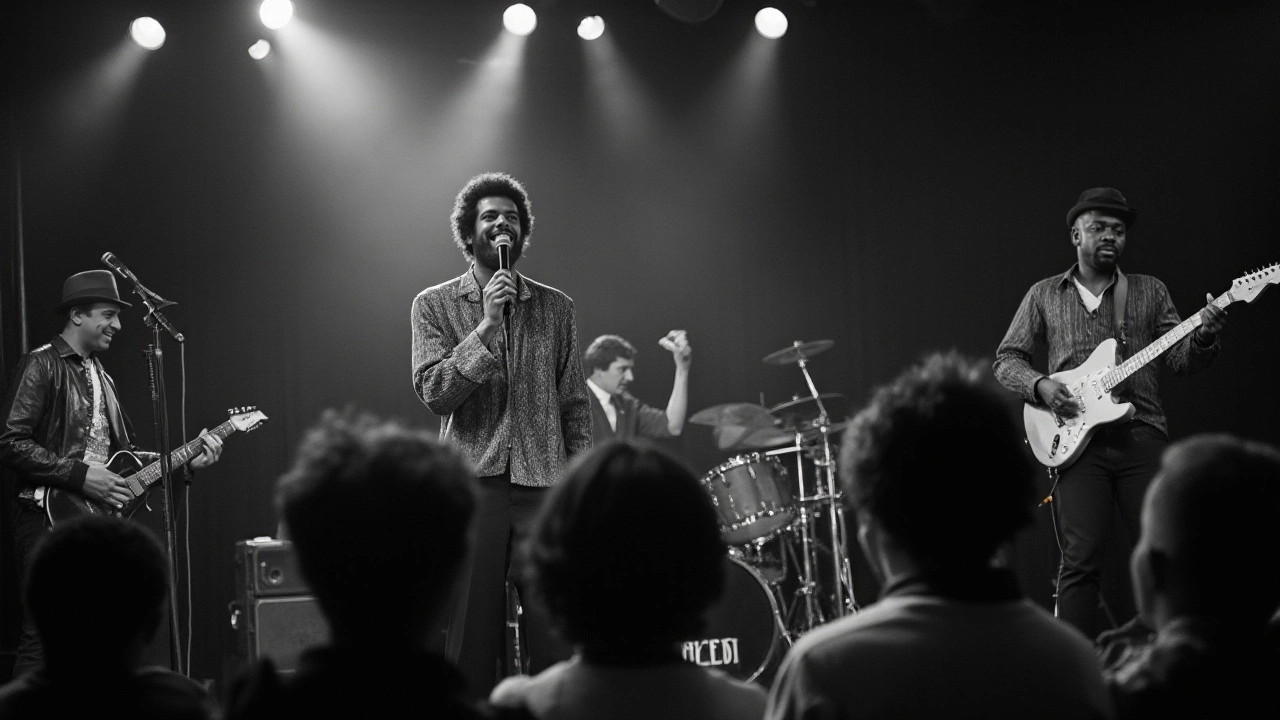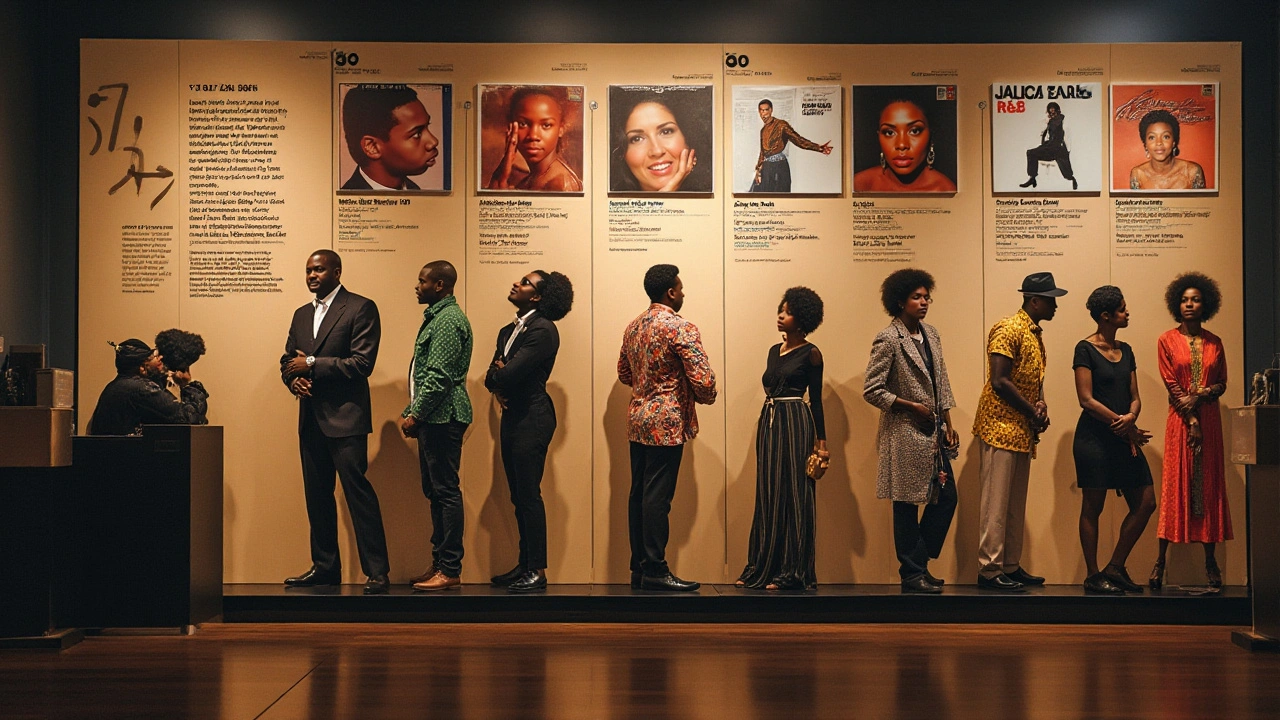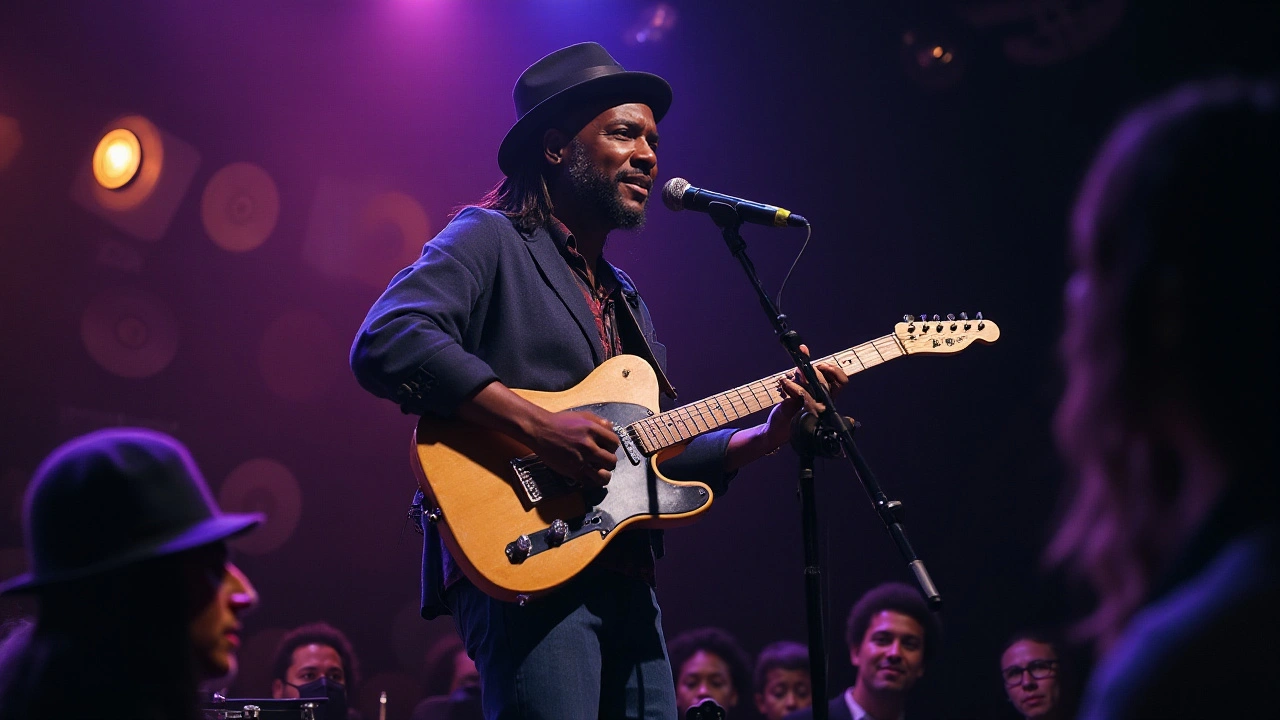If you've ever found yourself humming a smooth tune, feeling it resonate through your core, chances are you've been charmed by Rhythm and Blues (R&B). This genre has a unique way of gripping your senses and making you want to hit the replay button over and over.
R&B, with its deeply rooted history and soulful melodies, has stood the test of time as one of the most influential music genres. But what exactly makes it so irresistibly catchy? From its heartfelt lyrics to its syncopated beats, let's take a journey into what makes R&B magic that leaves listeners wanting more.
- Origins of Rhythm and Blues
- Key Characteristics of R&B
- Why Is R&B So Catchy?
- The Evolution of R&B Over the Years
- R&B's Impact on Modern Music
Origins of Rhythm and Blues
Rhythm and Blues, commonly known as R&B, finds its roots in the African-American communities of the 1940s and 1950s. Emerging from the Southern United States, R&B was a blend of jazz, gospel, and blues music, reflecting the cultural and social environments of that time. The term 'Rhythm and Blues' was first coined by Jerry Wexler of Billboard magazine in 1948 to categorize music that was then known as 'race music.'
Early R&B was characterized by a strong backbeat, piano or saxophone riffs, and heartfelt vocals that often spoke of love and life's hardships. Foundational artists like Ray Charles, who is often referred to as 'The Genius,' and Ruth Brown helped to define the early sound of R&B. Ray Charles's song 'I've Got a Woman' and Ruth Brown's 'Mama, He Treats Your Daughter Mean' are examples of tracks that pushed R&B into the mainstream. Their contributions laid the groundwork for the genre's evolution.
In the post-World War II era, many African-Americans migrated from the rural South to urban areas in the North in search of better opportunities. This Great Migration had a significant impact on the music industry, as it brought a diverse mix of cultural influences into cities like Chicago, Detroit, and New York. Chicago's South Side, for instance, became a jazz and blues hotspot, nurturing talents like Muddy Waters and Howlin' Wolf. These artists' blues-influenced sounds played a critical role in shaping R&B.
During the 1950s, the genre started to gain immense popularity with both black and white audiences. This was also the period when independent record labels like Atlantic Records and Chess Records began to grow. These labels were instrumental in promoting R&B artists and helping them reach a wider audience. Atlantic Records, founded by Ahmet Ertegun and Herb Abramson, became known for its roster of R&B legends such as Ray Charles and Aretha Franklin. Their innovative recording techniques and marketing strategies were key factors in the genre's rising fame.
"R&B wasn't just music; it was the voice of social change and an expression of cultural identity." - Ahmet Ertegun
The technological advancements of the time, including the introduction of the 45 RPM record, also played a crucial role in the dissemination of R&B music. Radio stations and jukeboxes brought this infectious genre into homes, bars, and clubs across America. This accessibility helped R&B to influence other music styles, setting the stage for rock and roll. Artists like Chuck Berry and Little Richard were heavily inspired by R&B, and in turn, helped to blur the lines between different music genres.
As we moved into the 1960s, the Civil Rights Movement was at its peak, and R&B became intertwined with calls for social justice. Songs like Sam Cooke's 'A Change Is Gonna Come' and Marvin Gaye's 'What's Going On' resonated deeply with audiences and became anthems of the movement. These songs showcased the power of R&B not just as a form of entertainment but also as a vehicle for change.
Key Characteristics of R&B
Rhythm and Blues, often called R&B, is a genre that comes with a set of defining features. At its core, R&B is all about emotion and soul. Its purpose is to move you, whether it’s physically on the dance floor or emotionally through the depth of its lyrics.
The rhythmic foundation of R&B is unmistakable. The genre often employs strong backbeats, typically on the second and fourth beats of a measure. This gives the music a danceable groove that is almost impossible to sit still to. These beats often come from drums, bass guitars, and electric guitars, creating a compelling and infectious rhythm.
Melody also plays a crucial role in R&B. Unlike genres that might focus heavily on rhythm or lyrics alone, R&B melds these elements together seamlessly. The melodies often follow a vocal pattern that could range from smooth and silky to powerful and soaring. This mixture makes every note feel perfectly placed and absolutely necessary.
Another standout feature is the lyrical content. R&B lyrics often delve into themes of love, heartbreak, and emotional struggle. These themes are universally relatable, giving the songs an additional layer of depth. It’s not just about the music; it’s about the story behind it. The lyrics often act as a narrative that takes the listener on an emotional journey.
The use of harmonies is another key aspect. R&B frequently incorporates rich, multi-layered vocal harmonies, enhancing the emotional impact of the song. This practice can be traced back to its roots in gospel music, where harmonization is a significant feature. When done correctly, harmonies can send shivers down the spine and elevate a song from good to unforgettable.
Instrumentation in R&B is particularly versatile. While traditional instruments like drums, bass, and guitars are common, R&B also embraces a variety of other instruments, from pianos to synthesizers. Some modern R&B tracks even incorporate electronic elements, blending the old with the new to create a fresh yet familiar sound.
“R&B is about a feeling. It’s music that speaks to the heart and moves the soul,” says a musicologist from the Berklee College of Music.
Vocals in R&B are often characterized by their emotive quality. Singers are not just delivering notes; they are expressing deep-seated feelings. Techniques like melisma, where a single syllable is stretched over several notes, are commonly used. This gives the music a dynamic, almost conversational quality.
Syncopation, or the deliberate disruption of the usual rhythmic flow, brings an element of surprise to R&B tracks. This makes the songs unpredictable and keeps the listener engaged. It’s a form of musical tension and release that can make a song endlessly interesting.
These characteristics combined make R&B so irresistibly catchy. Whether you’re a long-time fan or a newcomer to the genre, it’s hard to deny the magnetic pull of a well-crafted R&B track. From its compelling rhythms to its emotional depth, R&B captures the essence of human experience in a way that few other genres can.

Why Is R&B So Catchy?
When it comes to music genres, there’s no denying that Rhythm and Blues holds a special place in our hearts. But why exactly does it captivate us so? First and foremost, it's the blend of smooth melodies and syncopated beats that keeps listeners hooked. The rhythm section in R&B often employs intricate patterns that challenge conventional time signatures, creating an irresistible groove that’s hard to ignore.
Another key factor is the soulful and emotive vocals. The singers in R&B often pour their heart and soul into their performances. It's not just singing; it's storytelling. They take you on a journey through their emotions, making you feel every word and every beat. This connection between the artist and the listener is what makes R&B so compelling. In fact, Stevie Wonder once noted, "Music, at its essence, is what gives us memories. And the longer a song has existed in our lives, the more memories we have of it."
Lyrics also play a huge role in the genre's allure. R&B lyrics often speak to universal experiences - love, heartbreak, joy, and pain. These themes resonate deeply with listeners and make the songs relate to personal experiences. When you hear an R&B song, it often feels like the artist is singing about your own life, which amplifies its impact.
The use of harmonies and layered vocals also contributes to the catchiness of R&B. These elements add depth and texture, making the songs more dynamic and enjoyable. Artists like Marvin Gaye and Aretha Franklin mastered the art of harmonies, creating rich sonic landscapes that stay with you long after the song has ended.
Let’s not forget the innovation in instrumentation. R&B musicians often experiment with various instruments and sounds, incorporating elements from jazz, gospel, and blues. This fusion results in a unique sound that keeps evolving. Such diversity within the genre ensures that there’s something for everyone, making it broadly appealing.
The genre's infectious energy cannot be ignored either. Many R&B tracks feature upbeat tempos and lively rhythms that make you want to move. Whether it's dancing in your living room or tapping your feet at your desk, the physical reaction to R&B is undeniable. This universal appeal makes it a favorite at parties, clubs, and even casual listening.
Lastly, cultural significance adds to its allure. R&B has deep roots in African American history and culture. It has been a voice for social change and personal expression. This rich cultural backdrop imbues the genre with a sense of purpose and identity. Understanding this context allows listeners to appreciate the music on a deeper level, making it even more irresistible.
The Evolution of R&B Over the Years
The journey of Rhythm and Blues has been nothing short of remarkable. Starting in the 1940s, R&B originated as a staple within African American communities. Early on, artists like Ray Charles and Ruth Brown laid the groundwork for what would become a genre rich with raw emotion and powerful stories.
By the 1960s and 1970s, R&B began to intertwine more with the emerging soul music scene. Icons like Aretha Franklin and Marvin Gaye brought a socially conscious edge to their music, weaving in themes of love, struggle, and liberation. This period also saw the rise of Motown, which became a powerhouse, delivering artists like Stevie Wonder and The Supremes to the forefront of the global music stage.
The 1980s ushered in a new era for R&B. The advent of electronic instruments and production techniques led to the genre blending with funk, hip-hop, and pop. Artists like Michael Jackson and Whitney Houston became crossover sensations, bringing R&B to an even wider audience. Their use of synthesized sounds and high-energy performances set the stage for what modern R&B would look like.
"R&B means so many things to so many different people. It's a genre that has evolved just as much as the world around it." – Ne-Yo
In the 1990s and early 2000s, R&B found itself once again at the crossroads of innovation and tradition. The era gave rise to boy bands and girl groups like Boyz II Men and Destiny’s Child, who harmonized their way to the top of the charts. Solo artists such as Usher, Alicia Keys, and Mary J. Blige continued pushing the boundaries, infusing their music with elements of hip-hop, which resulted in incredibly catchy, genre-defining hits.
The 2010s marked a period of both reflection and innovation. Contemporary artists like Beyoncé, The Weeknd, and Frank Ocean drew heavily from the rich history of R&B while merging it with an eclectic mix of genres, making the music both nostalgic and fresh. During this time, the advent of streaming services also played a crucial role in broadening the reach of R&B, allowing fans all over the world to access both classic tracks and new releases with ease.
Today, R&B continues to evolve under the influence of a new generation of artists. Musicians like H.E.R., SZA, and Khalid blend traditional soundscapes with modern themes, creating a unique, futuristic expression of the genre. What's most captivating is how R&B serves as a cultural touchstone, reflecting societal changes while also providing a soundtrack to our lives.

R&B's Impact on Modern Music
As we look at the sprawling landscape of today’s music, the influence of R&B is undoubtedly evident. This genre has seamlessly woven itself into various musical styles, leaving an indelible mark on pop, hip-hop, and even electronic dance music. Artists from diverse backgrounds have taken their cues from the emotive and rhythmically rich elements of R&B, adopting its soulful melodies and intricate beats to craft their own hits.
One of the most significant aspects of R&B's impact is its ability to blend with different genres seamlessly. Take pop music, for example. Pop stars like Beyoncé and Justin Timberlake have infused their tracks with R&B vibes, resulting in chart-topping singles that resonate with a broad audience. By integrating the emotional depth of R&B, these artists create songs that are not only catchy but also meaningful.
“R&B has an undeniable influence on contemporary music. The way it conveys raw emotion through complex rhythms and melodies is something that other genres strive to emulate,” says Mark Ronson, renowned music producer.
Then there's the world of hip-hop, where R&B has been a cornerstone since the genre's inception. Hip-hop tracks often feature R&B hooks and choruses, lending a soulful touch to rap verses. This fusion creates a dynamic listening experience, and artists like Drake and The Weeknd have mastered this blend, achieving massive commercial success. The smooth, melodic elements of R&B balance the harder beats and lyrics of hip-hop, providing a perfect and captivating harmony.
Electronic dance music (EDM) has also seen a surge of R&B influence. Producers like Calvin Harris and Disclosure have collaborated with R&B vocalists to create tracks that dominate dance floors. The soulful, expressive vocals add a layer of complexity and emotional depth to the pulsating EDM beats, making these songs not just danceable but also memorable.
If we look at the streaming platforms, R&B's presence is crystal clear. Spotify’s playlists for genres like chill, party, and even workout often feature R&B tracks or artists. This consistent inclusion testifies to R&B’s versatility and wide-ranging appeal. Listeners are drawn to the genre’s ability to evoke emotions, whether through a slow ballad or an upbeat groove.
It’s also worth noting how R&B has impacted songwriting and production techniques. The genre's sophisticated approach to layering vocals, applying harmonies, and using syncopated rhythms has raised the bar for musical craftsmanship. Producers from other genres often adopt these methods to add a refined touch to their tracks, aiming for that distinct, polished sound that R&B is known for.
The ripple effect of R&B’s impact extends to live performances as well. When artists incorporate R&B elements into their shows, they create a more engaging and interactive experience for the audience. The emotional delivery and dynamic stage presence associated with R&B performances captivate the crowd, making concerts more memorable and immersive.
The Future of R&B Influence
Looking ahead, the influence of R&B shows no signs of waning. As more artists experiment with hybrid genres, blending traditional and contemporary musical styles, R&B will continue to serve as a foundational element. Emerging artists are also proving that the genre has plenty of room for innovation, pushing boundaries while staying true to its roots. With its rich history and endless adaptability, R&B will undoubtedly shape the future of music for years to come.

